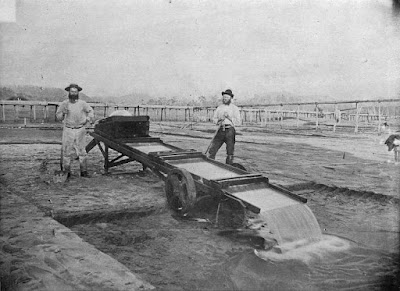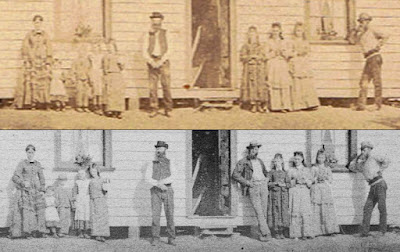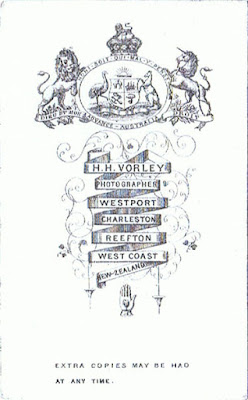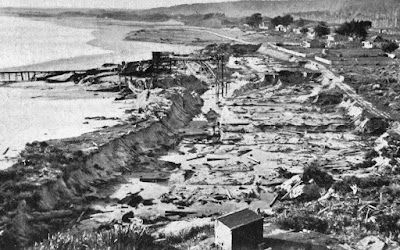
The 83rd Carnival of Genealogy, hosted by Janet Isles at her blog Janet the Researcher, is entitled Play Me, and encourages Geneabloggers to write about a musical instrument that they or other family members have played. Apart from my youngest daughter and aunt who both, like the elegantly coiffured and dressed lady in the footnoteMaven's inviting COG poster above, have learned to play the piano during their school years, very few of my family members have progressed much beyond the recorder in their early grades. However, my great-grandfather Charles Vincent Payne (1868-1941) did have something of a reputation for his singing voice.
Of course I never met my great-grandfather. He died twenty years before I was born and, since my father and his sister were pretty young at the time, they never recalled much about him either. He has therefore been far less prominent a figure in the family history than his younger brother, Charles Hallam Payne (1870-1960), who lived almost two decades longer, was always known as "the grand uncle" and generally regarded as the head of the family.

Charles Vincent Payne, c.1915-1920
Post card portrait, possibly by Pollard Graham of Derby
Image © and collection of Brett Payne
Colourised by Andre Hallam
I am interested, therefore, in how much we can deduce about the type of person Charles Vincent was from the photographs and meagre ephemeral clues that we have. The postcard portrait above, expertly colourised for me by Andre Hallam, was probably taken in Derby. Although not marked with a studio name it is of a style and format used by the Pollard Graham in the period 1915-1920, when he was aged about fifty, and the backdrop is very similar to those used in Graham's Derby studio. He seems rather pleased with himself, looking confidently at the camera, with his right hand partly in his jacket pocket, and holding his pipe in his left hand. He is dressed, as always, very smartly in a dark suit with waistcoast, collar and bow tie, and a light-coloured trilby with a dark hat band.
The earliest reference that I have found for his prowess as a singer is the report of a concert held by the Normanton Musical Society on 28 January 1889, probably at St Giles church, Normanton. [1] He was the first of a dozen soloists and duet performances in a lengthy evening's entertainment:
"Mr. Vincent Payne received a well-merited encore for his song 'They all love Jack,' to which he responded with 'The Old Brigade.'"He was at this time working as a carriage finisher - in other words as a skilled joiner - at the Midland Railway works in Litchurch, Derby. He and Amy Robinson, daughter of a local policeman, were married at St. Thomas Church at Litchurch in May the following year, and almost immediately they headed off for Chicago, accompanied by another brother Frank Payne, to join Hallam who was working for the Pullman Car Company. After leaving the port of Liverpool in late May, they arrived in the port of Baltimore aboard the S.S. Nova Scotian on Wednesday 10 June 1891.

Charles Vincent Payne, August 1891
Cabinet card by Harrison & Coover, Central Music Hall,
cnr. State & Randolph Streets, Chicago, Illinois
Image © and collection of Brett Payne
Why did they go to America? Was it the allure of the forthcoming World's Columbia Exposition, which attracted millions? Although it is likely that Charles Vincent and Frank had both planned to join Hallam working at Pullman - their destination is listed as "Pullman, Ill." on the passenger list - it seems this did not happen. The only clues that I have for Charles Vincent's activities during those first few months are some notes made by my father of a conversation with his great-uncle Hallam in 1959 [6]:
"After one year Vincent, newly married, came out and for some time was jobless. Eventually got job, was to go with a troupe touring States as a singer. They fell on CV as makeshift - but the other fellow turned up so that was off. CV gets along with a man one of these variety artist blokes who had been an Arizona cowboy - he did tricks and Frenchman who did vanishing lady. Went round village in Illinois, CV handing out bills in am [morning]. After show was over fetch bills back. Frenchman used to go to next place and spout about the show. They went to a place called Warconder, 10 miles from Chicago."It must have been at around this time that Charles Vincent visited the photographic studio of Harrison & Coover in the Central Music Hall, on the corner of State and Randolph Streets in Chicago to have a portrait taken. We have three copies of the portrait shown above - one of them has the date "August 1891" written in an apparently contemporary hand on the reverse.

Central Music Hall, Chicago, c.1890s
Stereoview (Left half) by unidentified photographer
Robert N. Dennis collection of stereoscopic views
Image © and courtesy of the New York Public Library Digital Collection
Image ID: G90F171_006F
A quick search on the net reveals that Harrison & Coover's subjects were often from the music and entertainment industry, which is perhaps not surprising since the studio was located in the building which housed the popular Central Music Hall. The image above, taken from a stereoview of the period, shows a likely studio location with a frieze of large plate glass windows on the sixth floor. It seems likely to me that Charles Vincent had his portrait taken here as a means of furthering his job prospects.

Cad. Wilson & Madge Davenport, c.1891-1892
Cabinet card by Harrison & Coover, Central Music Hall, Chicago
Image © The New York Public Library for the Performing Arts, Lincoln Kirstein Collection & Courtesy of the NYPL Digital Gallery
Ref. MOMA_0077V
The Chicago industry was perhaps a little different from the musical society gatherings that he was used to. Harrison & Coover's other clients included Cad. Wilson and Madge Davenport, who provoked the following review in The Buffalo Courier of 22 September 1891:
"In the Congo dance Cad Wilson and Madge Davenport create a sensation. When women dance, however, their movements should be graceful rather than exhibit [missing text] audience, it is reasonable to suppose, who enjoy seeing a woman twist herself into the postures of a contortionist." [8]... and in June-July 1892 appeared in the musical "A Trip to Chinatown" at Hoyt's Madison Square Theatre in New York, but "failed to please" and their dance was soon withdrawn from the repertoire. [9] Cad Wilson later gained notoriety as one of the most successful of the "good time girls" of the Klondike gold rush [10][11], while Madge Davenport appears to have ended her days in much less fortunate circumstances. [12] Another customer of Harrison & Coover was the provocative Kittie Wells, dubbed Chicago's "Queen of the Levée." [13][14]
Performances at the Central Music Hall, however, were not always of the musical variety, public lectures often attracting the "brains, fashion and wealth of Chicago society." [15] Charles Vincent was, no doubt, quite out of his depth in such a sophisticated entertainment industry, and my guess is that this is why he stumbled into a vaudeville outfit touring the towns surrounding Chicago.
"Hallam wanted to know whether CV wanted to go into fresh lodgings or a flat. So Hallam went by train to Warconder - but they'd left for Machenry 10 miles further on, so lodged in ice cream saloon for the night. Proprieter drove Hallam to Machenry at 5 am the following day. CV decided to take flat and told Hallam that at last place's performance they'd pinched Hall curtains. Followed by sheriff's posse. A black man called Whistling Bird joined troupe and CV left."Wauconda and McHenry were very small towns 50 to 60 miles north-west of Chicago. The prospects seem to me to have been decidely risky, even without having the sheriff's posse on one's tail and Amy would, no doubt, have been relieved at Charles Vincent's role being supplanted by a man whose speciality was imitating bird whistles. Vaudeville whistling, and more particularly imitating bird sounds, became popular in the 1880s and 1890s, but has always remained the preserve of fairground-type performances. [16]

Unidentified man, possibly Frank Payne, 1892
Sixth-plate tintype portrait by unidentified photographer, Chicago, Illinois
Image © and courtesy of Barbara Ellison
"To get back he got up on gravel truck with only a roll of music. Arrived early am. Got flat next day. Frank [his younger brother] was there then having come over with CV and wife. Frank and Hallam slept on mattress in front room. Heard burglars trying to get in a couple of nights. Sat up one night - but went to sleep, and then there was revolver shot. CV had shot at shadow on window frame, hitting frame. The burglars tried again and we told police - but they were never caught. At this time Hallam was joiner at Pullman Car Co."This flat where all four of them stayed was possibly the 10810 Curtis Ave, Roseland, Chicago address where Amy later gave birth to my grandfather Charles Leslie Lionel Payne on 9 April 1892. By then Charles Vincent and Hallam had found jobs at the Chicago World's Fair, or to give it it's proper name, The World's Columbian Exposition, where they were employed as carpenters working on the dome of the Horticultural Building. Within seven months, however, they had decided to call it quits and returned home to England via Montreal, arriving at Liverpool on board the S.S. Circassian on 30 November.
From June 1894 until February 1896 Charles Vincent ran the family grocery shop and off-licence at 83 St James' Road, New Normanton and possibly assisted his father in the latter's building operations. After handing the shop over to Hallam he became an estate agent, and remained in this business until his retirement, probably in the 1920s.

Charles Vincent Payne, c.1894
Cabinet card by Pollard Graham, Derby
Image © and collection of Brett Payne
This cabinet card portrait of Charles Vincent was taken by Pollard Graham in Derby, probably around 1894, after he had returned to England. He appears to be dressed in some sort of fancy dress with frilly shirt, jacket embellished with braid and velvet trim and cowboy's hat. I have always thought that this must be related to his singing career in some way, either a pose in clothes which he had brought back with him from the States, or part of an act which he performed in Derby. He certainly did continue with the amateur singing, as the following excerpt from The Derby Mercury (16 May 1900) demonstrates.
"A smoking concert was held in aid of the Normanton Reservists' Fund (now affiliated with the Derbyshire Transvaal War Fund) on Wednesday evening at the Sherwood Hotel ... The programme was as follows: Part 1 ... song, 'Skipper,' Mr. C. Vincent Payne ... Part 2 ... song, "Anchored," Mr. C. Vincent Payne ... song, "Drinking," Mr. C. Vincent Payne ... a most enjoyable evening was spent." [19]

Large group, Old Bell Hotel courtyard, Sadlergate, Derby, c.1920s
Post card portrait by unidentified photographer
Image © and collection of Brett Payne
As he got older, I think the "drinking" aspect of these recreational activities may have taken over from the music. This postcard portrait of a large group of men, a young porter and a solitary, somewhat disgruntled, young woman (perhaps a barmaid unwillingly coerced into posing) in the courtyard behind the Old Bell Hotel in Derby is titled, "Ding Dongs." Charles Vincent is standing in the back row, second from right. The meaning of this title has sadly - or perhaps fortuitously - been lost over the years but, from the number of subjects imbibing beer and tobacco, they had obviously recently decamped from the bar.
Charles Vincent Payne died at his home at "The Hill", Chellaston, Derby on 25 July 1941 at the age of 73. The death certificate reveals that his lifestyle took its toll in the end.
Cause of Death:References
a. Myocardial Degeneration
b. Cerebral Haemorrhage
c. Arteriosclerosis
d. Carcinoma of Tongue
Certified by MD Groves MRCS [21]
1. Post card portrait of Charles Vincent Payne, taken c. 1915-1920, by unidentified studio photographer [possibly Pollard Graham, Derby], Collection of Brett Payne. (Digital image colourised by Andre Hallam)
2. The Derby Mercury, 6 February 1889, 19th Century British Library Newspapers from Gale CENGAGE Learning
3. Cabinet card portrait of Charles Vincent Payne, taken August 1891 by Harrison (Thomas) & Coover (D.R.), Central Music Hall, State & Randolph Streets, Chicago, Collection of Brett Payne.
4. Cabinet card portrait of Charles Vincent Payne, dated August 1891, taken by Harrison (Thomas), Central Music Hall, State & Randolph Streets, Chicago, Collection of Barbara Ellison.
5. Stereoview of Central Music Hall, Chicago, c.1890s, taken by unidentified photographer, Robert N. Dennis collection of stereoscopic views, New York Public Library Digital Collection, Image ID: G90F171_006F.
6. Notes of Conversation, 1959, between Charles Hallam Payne (1870-1960) and Charles Bernard Payne (1928-2006), Collection of Brett Payne.
7. Cabinet card portrait of Cad. Wilson & Madge Davenport, c. 1891-92, taken by Harrison & Coover, Central Music Hall, State & Randolph Streets, Chicago. The New York Public Library for the Performing Arts, Lincoln Kirstein Collection. Courtesy of the NYPL Digital Gallery. Ref. MOMA_0077V.
8. Amusements, Extract from The Buffalo Courier, 22 September 1891, Buffalo, New York. Source: New York State Library Microfilm, from Newspaper Abstracts.
9. Odell, George C.D. (1949) Annals of the New York Stage, Vol. 15: 1891-1894. New York, NY: Columbia University Press, p. 41.
10. Morgan, Lael (1999) Good Time Girls of the Alaska-Yukon Gold Rush: A Secret History of the Far North, Alaska Book Adventures, p. 72. [Partially available online at Google Books]
11. Berton, Pierre (1958) Klondike. London: W.H. Allen. 456p.
12. Morbid Fact du Jour - Archive, 1 June 2008, from Low Life: Lures and Snares of Old New York, by Luc Sante (2003), Farrar Straus & Giroux.
13. Cabinet card portrait of Kittie Wells, c. 1891-92, taken by Harrison & Coover, Central Music Hall, State & Randolph Streets, Chicago. Courtesy of PictureHistory Prints, Ref. MES10765.
14. Stevens, Grant Eugene (1906) Wicked City, Chicago, p.108. [Available online at the Internet Archive]
15. Dedmon, Emmett (1953) Fabulous Chicago. New York: Random House, Inc. p.202.
16. Schlitz, J.M. (n.d.) Whistletainment, in Kunstpfeifen: an Overview.
17. Sixth-plate tintype portrait of unidentified man [possibly Frank Payne], 1892, taken by unidentified photographer, Chicago, Illinois. Collection of Barbara Ellison.
18. Cabinet card portrait of Charles Vincent Payne, taken c.1894 by Pollard Graham of Derby & Burton-on-Trent. Collection of Brett Payne.
19. The Derby Mercury, 16 May 1900, 19th Century British Library Newspapers from Gale CENGAGE Learning
20. Post card portrait of large group, c. 1920s, Old Bell Hotel courtyard, Sadlergate, Derby, by unidentified photographer. Collection of Brett Payne.
21. Certified Copy of an Entry of Death for Charles Vincent Payne, died 25 July 1941, Registered at Derby, 28 July 1941. [Photocopy] Collection of C.B. Payne.


























































